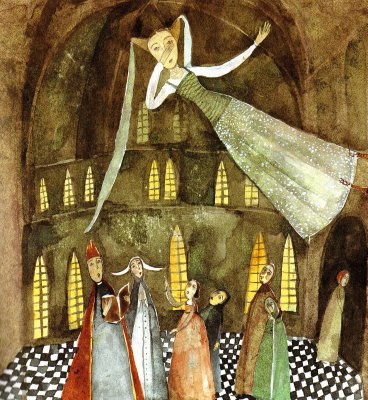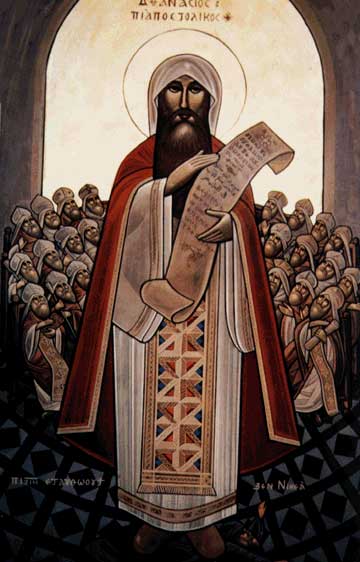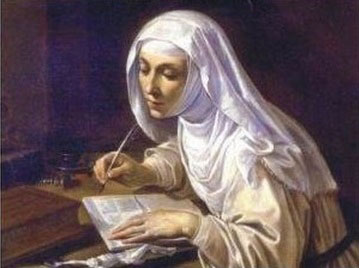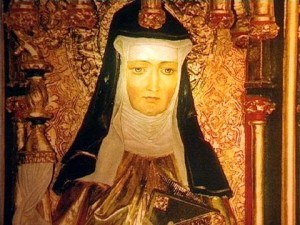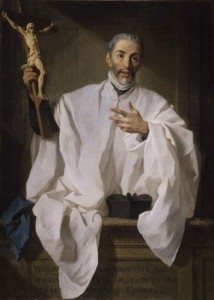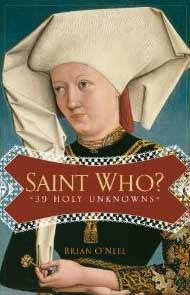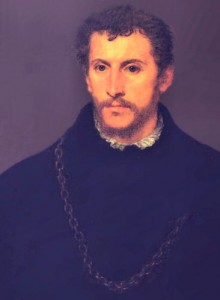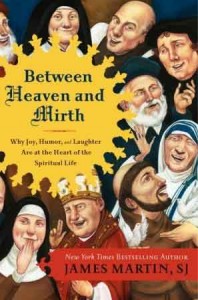 Who is she? Men and women throughout the centuries have tried to define her…all I know for sure is that she was freed and healed from 7 demons, stayed with Our Lady at the foot of the Cross, and was chosen by Christ to be the first witness to the Resurrection…she would become the Apostle to the Apostles…that’s enough for me.  Wow! Who is she? One of the
Who is she? Men and women throughout the centuries have tried to define her…all I know for sure is that she was freed and healed from 7 demons, stayed with Our Lady at the foot of the Cross, and was chosen by Christ to be the first witness to the Resurrection…she would become the Apostle to the Apostles…that’s enough for me.  Wow! Who is she? One of the 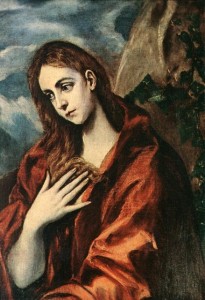 greatest saints…ever!
greatest saints…ever!
One of the best conversations we’ve had about St. Mary Magdalene was with the wonderful Amy Welborn, author of “Decoding Mary Magdalene”
[powerpress]
Artists and musicians have tried to capture Mary Magdalene;  here’s a beautiful tribute to their efforts:
Tags: amy welborn, catholic, catholic podcast, catholic prayer, cathollc spirituality, demons, our sunday visitor, saints, st mary magdalene, witness, women
This entry was posted on Tuesday, July 22nd, 2014 at 5:07 am
You can follow any responses to this entry through the RSS 2.0 feed.
What a joy to talk about the saints with Paul Thigpen. and discuss this INCREDIBLE book! Not just an ascetically gorgeous work, worthy of the 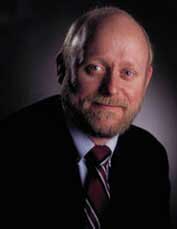 mystery it contains, but “A Year With the Saints: Daily Meditations with the Holy Ones of God” is filled with guided meditations, teachings, and prayers with the “Great Cloud of Witnesses”. Dr. Thigpen, who earned his PhD in Church History, also guides through a wonderful catechesis of the faith through these “love letters” from history.  The perfect gift…period.
mystery it contains, but “A Year With the Saints: Daily Meditations with the Holy Ones of God” is filled with guided meditations, teachings, and prayers with the “Great Cloud of Witnesses”. Dr. Thigpen, who earned his PhD in Church History, also guides through a wonderful catechesis of the faith through these “love letters” from history.  The perfect gift…period.
In this conversation, we discuss many topics, including:
Why the saints? Do we need them? How can they help us grow in faith?
[powerpress]
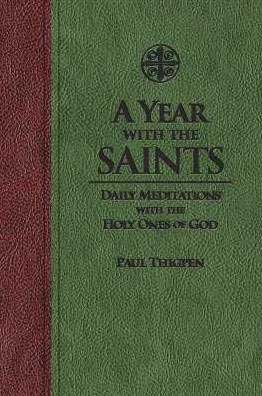 You can find the book here
You can find the book here
“Those who follow the saints”, said Pope Clement I, “will themselves become saints”. Their words and deeds provide a treasury of time-tested wisdom, encouragement, and inspiration for the pursuit of holiness.
Best-selling Catholic author Paul Thigpen opens up that treasury in A Year With the Saints: Daily Meditations With the Holy Ones of God. These 365 reflections draw from the writings and lives of holy men and women across two thousand years. Their spiritual and practical insights for Christian living are as fresh and relevant today as they were when they were first written.
Tags: faith, paul thigpen, saints, work
This entry was posted on Wednesday, November 27th, 2013 at 8:06 am
You can follow any responses to this entry through the RSS 2.0 feed.
Stunning…simply stunning. I love “Mysteries of the Virgin Mary: Living Our Lady’s Graces”! A beautiful and lovingly assembled collection of and meditations on the 13 principal Marian mysteries celebrated by the Church. From the sound theological foundations for our devotion to Our Lady to the reflections and teachings of the saints, Fr. Peter John Cameron, founding editor-in-chief of the monthly worship aid Magnificat, has given us a wonderful resource to deepen our walk with the Blessed Mother of God.
Graces”! A beautiful and lovingly assembled collection of and meditations on the 13 principal Marian mysteries celebrated by the Church. From the sound theological foundations for our devotion to Our Lady to the reflections and teachings of the saints, Fr. Peter John Cameron, founding editor-in-chief of the monthly worship aid Magnificat, has given us a wonderful resource to deepen our walk with the Blessed Mother of God.
[powerpress]
 You kind find this book at www.servantbooks.org
You kind find this book at www.servantbooks.org
Here is the extended web-exclusive edition of our “Inside the Pages” interview with Fr. Cameron[powerpress url=”http://www.old.discerninghearts.com/interviews/Inside_the_Pages-Fr_Peter_John_Cameron_special_extended_edition.mp3″]Download (right click & choose “Save Link As”)
Tags: blessed mother, Church, devotion, graces, marian, meditations, mother of god, mysteries, peter john cameron, reflections, saints, servant books, virgin mary
This entry was posted on Thursday, September 12th, 2013 at 11:13 am
You can follow any responses to this entry through the RSS 2.0 feed.
Join Teresa Monaghen, of Pro Sanctity, as she offers a “Personal Plan for Holiness”. Listen along with these short, but beautiful meditations which encourage us to continue on our journey as “saints in the making”!
beautiful meditations which encourage us to continue on our journey as “saints in the making”!
[powerpress]
Learn more about Pro Sanctity at www.prosanctity.org
Tags: Join Teresa Monaghen, meditations, personal plan for holiness, pro sanctity, saints, teresa monaghen
This entry was posted on Friday, September 6th, 2013 at 12:08 am
You can follow any responses to this entry through the RSS 2.0 feed.
Praying to Saints
[powerpress]
On this faith check let’s answer the question, “why pray to a saint when you can pray straight to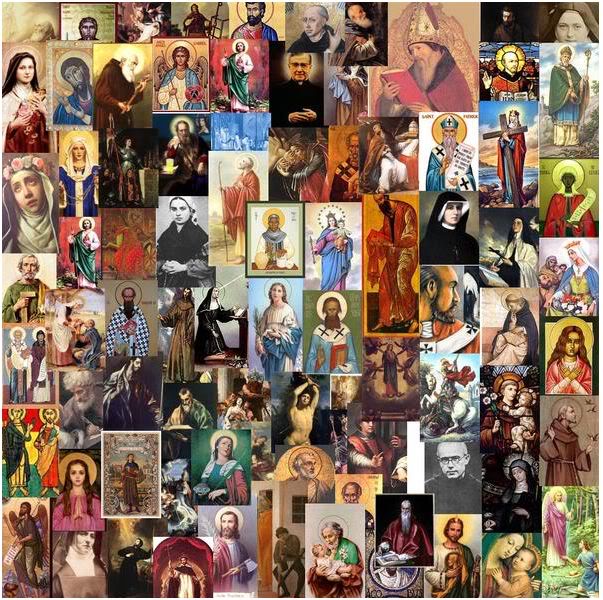 God?â€
God?â€
Of course, Catholics can and do pray straight to God. But we also pray to saints, not to worship them, but simply to ask for their prayers on our behalf, just like we ask our friends on earth to pray for us.
In the communion of saints we are spiritually connected to believers in the here and now and in the hereafter. For instance, Hebrews tells us we are surrounded by a “great cloud of witnesses,â€1 who are aware of what’s going on here. We read in Revelation that the prayers of the elders and saints in heaven are ascending before the throne of God.2
The prayers of the saints are powerful because they have been perfected in God’s grace and as St. James says, “the fervent prayer of the righteous has great power.â€3
Early Christian writings demonstrate that this practice was not a later corruption, but goes back to the very first centuries of Christianity. So let us join with Christians of all ages in saying “all you holy men and women, pray for us!â€
1 -Â 12:1
2 -Â 5:8; 8:3; etc.
3 -Â 5:16
Tags: cloud of witnesses, communion of saints, faith, prayers, prayers of the saints, praying to saints, saints, women
This entry was posted on Monday, July 29th, 2013 at 12:09 am
You can follow any responses to this entry through the RSS 2.0 feed.
A Prayer to St. Christina
[powerpress]
Today is the feast day of St. Christina the Astonishing. Why is she astonishing…well, if everyone thought you were dead and during the course of your funeral you shot up and proceeded to levitate to the rafters of the church, they’d probably call you astonishing too. Now I’ve been known to fly into a panic and fly into a rage, and I even fly to Costco for a good deal…but fly in church? Nope, not me. But all things are possible, with God. This is just one of the stories I read about her a long time ago in an old version of Bulter’s Lives of the Saints.  What else do we know:
After her death experience, she related that she had witnessed heaven, hell, and purgatory. It is written that she said “As soon as my soul was separated from my body it was received by angels who conducted it to a very gloomy place, entirely filled with souls” where the torments there that they endured “appeared so excessive” that it was “impossible to give an idea of their rigor.”
She continued,”I saw among them many of my acquaintances” and touched deeply by their sad condition asked if this was Hell, but was told that it was Purgatory. Her angel guides brought her to Hell where again she recognized those she had formerly known. Next she was transported to Heaven, “even to the Throne of Divine Majesty” where she was “regarded with a favorable eye” and she experienced extreme joy and these words were spoken to her, ” Assuredly, My dear daughter, you will one day be with Me. Now, however, I allow you to choose, either to remain with Me henceforth from this time, or to return again to earth to accomplish a mission of charity and suffering. In order to deliver from the flames of Purgatory those souls which have inspired you with so much compassion, you shall suffer for them upon earth: you shall endure great torments, without however dying from their effects. And not only will you relieve the departed, but the example which you will give to the living, and your continual suffering, will lead sinners to be converted and to expiate their crimes. After having ended this new life, you shall return here laden with merits.”
Christina, at hearing this and “seeing the great advantages for souls” without hesitation she agreed to return to life and arose that same moment. She told those around her that for the sole purpose of relief of the departed and conversion of sinners did she return and that none should be astonished at the penances that she would practice, nor the life that she would lead hence forth, she is quoted as saying, “It will be so extraordinary that nothing like it has ever been seen.” Making penances for the souls of Purgatory and Hell would henceforth become a major theme in her life.
As chronicled by her contemporaries, she threw herself into burning furnaces and there suffered great tortures for extended time uttering frightful cries, yet coming forth with no sign of burning upon her. In winter she would plunge into the frozen Meuse River for hours and days and weeks at a time all the while praying to God and imploring His Mercy. She allowed herself to be carried by the currents down river to the mill where the wheel “whirled her round in a manner frightful to behold” yet she had no dislocations or broken bones. She was chased by dogs that bit and tore her flesh. She ran from them into thickets of thorns, and though covered in blood she would return with no wound or scar.
Christina died in 1224 of natural causes, aged 74. – Wikipedia
After reading this, maybe you might want to, at least, pray with St. Christina the Astonishing, for the Poor Souls in Puragatory…click on this link to join in
Tags: angels, conversion, death experience, feast day, hell and purgatory, His Mercy, Meuse River, mission, saints, suffering, women of the middle ages
This entry was posted on Wednesday, July 24th, 2013 at 12:02 am
You can follow any responses to this entry through the RSS 2.0 feed.
St. Athanasius is one of the great Father and Doctors of the Church…the Father of Orthodoxy. His extraordinary life is shared with us by Mike Aquilina. When we say “consubstantial” at mass it’s due in part to St. Athansius and the battle against the Arian Heresy. Take a listen and learn more…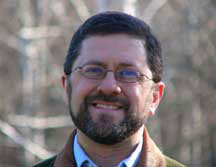
[powerpress]
More on the life of St. Athanasius from Pope Benedict at Vatican.va
GENERAL AUDIENCE
Paul VI Audience Hall
Wednesday, 20 June 2007
Continuing our revisitation of the great Teachers of the ancient Church, let us focus our attention today on St Athanasius of Alexandria.
>Only a few years after his death, this authentic protagonist of the Christian tradition was already hailed as “the pillar of the Church” by Gregory of Nazianzus, the great theologian and Bishop of Constantinople (Orationes, 21, 26), and he has always been considered a model of orthodoxy in both East and West.As a result, it was not by chance that Gian Lorenzo Bernini placed his statue among those of the four holy Doctors of the Eastern and Western Churches – together with the images of Ambrose, John Chrysostom and Augustine – which surround the Chair of St Peter in the marvellous apse of the Vatican Basilica.
Athanasius was undoubtedly one of the most important and revered early Church Fathers. But this great Saint was above all the impassioned theologian of the Incarnation of the Logos, the Word of God who – as the Prologue of the fourth Gospel says – “became flesh and dwelt among us” (Jn 1: 14).
For this very reason Athanasius was also the most important and tenacious adversary of the Arian heresy, which at that time threatened faith in Christ, reduced to a creature “halfway” between God and man, according to a recurring tendency in history which we also see manifested today in various forms.
In all likelihood Athanasius was born in Alexandria, Egypt, in about the year 300 A.D. He received a good education before becoming a deacon and secretary to the Bishop of Alexandria, the great Egyptian metropolis. As a close collaborator of his Bishop, the young cleric took part with him in the Council of Nicaea, the first Ecumenical Council, convoked by the Emperor Constantine in May 325 A.D. to ensure Church unity. The Nicene Fathers were thus able to address various issues and primarily the serious problem that had arisen a few years earlier from the preaching of the Alexandrian priest, Arius.
With his theory, Arius threatened authentic faith in Christ, declaring that the Logos was not a true God but a created God, a creature “halfway” between God and man who hence remained for ever inaccessible to us. The Bishops gathered in Nicaea responded by developing and establishing the “Symbol of faith” [“Creed”] which, completed later at the First Council of Constantinople, has endured in the traditions of various Christian denominations and in the liturgy as the Niceno-Constantinopolitan Creed.
In this fundamental text – which expresses the faith of the undivided Church and which we also recite today, every Sunday, in the Eucharistic celebration – the Greek term homooúsiosis featured, in Latin consubstantialis: it means that the Son, the Logos, is “of the same substance” as the Father, he is God of God, he is his substance. Thus, the full divinity of the Son, which was denied by the Arians, was brought into the limelight. (more…)
Tags: Church, faith, saints, St Athanasius
This entry was posted on Thursday, May 2nd, 2013 at 12:26 am
You can follow any responses to this entry through the RSS 2.0 feed.
To Nanna, daughter of Benincasa, a little maid, her niece, in Florence:
 Now, then, we must have light–otherwise it would not be enough. This light has to be the light of most holy faith. But the saints say that faith without works is dead. Therefore we need to exert ourselves virtuously all the time, and leave our childishness and vanities, and not behave any longer like worldly girls, but like faithful brides consecrated to Christ crucified; in this way we shall have a lamp, and oil, and light.
Heavenly Father, your glory is in your saints. We praise your glory in the life of the admirable St. Catherine of Siena, virgin and doctor of the Church. Her whole life was a noble sacrifice inspired by an ardent love of Jesus, your unblemished Lamb. In troubled times she strenuously upheld the rights of His beloved spouse, The Church. Father, honor her merits and hear her prayers for each of us. Help us to pass unscathed through the corruption of this world, and to remain unshakably faithful to the church in word, deed, and example. Help us always to see in the Vicar of Christ an anchor in the storms of life, and a beacon of light to the harbor of your Love, in this dark night of your times and men’s souls. Grant also to each of us our special petition . . . (pause to pray for your own intentions). We ask this through Jesus, your Son, in the bond of the Holy Spirit. Amen.
St. Catherine of Siena, Pray for us.
For the complete novena visit the St. Catherine of Siena Novena Page
Tags: faith, Jesus, saints, works
This entry was posted on Wednesday, April 24th, 2013 at 12:02 am
You can follow any responses to this entry through the RSS 2.0 feed.
[powerpress]
O God,
who by the Immaculate Conception
of the Blessed Virgin Mary,
did prepare a worthy dwelling place for Your Son,
we beseech You that,
as by the foreseen death of this, Your Son,
You did preserve Her from all stain,
so too You would permit us,
purified through Her intercession,
to come unto You.
Through the same Lord Jesus Christ,
Your Son, who lives and reigns with You
in the unity of the Holy Spirit,
God, world without end.
Amen.
O Mary, ever blessed Virgin,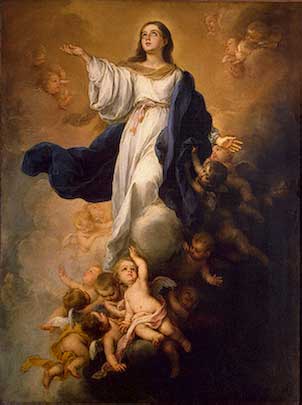
Mother of God,
Queen of angels and of saints,
we salute you with the most profound veneration
and filial devotion
as we contemplate your holy Immaculate Conception,
We thank you for your maternal protection
and for the many blessings that we have received
through your wondrous mercy
and most powerful intercession.
In all our necessities
we have recourse to you
with unbounded confidence.
O Mother of Mercy,
we beseech you now to hear our prayer
and to obtain for us of your Divine Son
the favor that we so earnestly request in this novena…
(State your intention here…)
O Mary of the Immaculate Conception,
Mother of Christ,
you had influence with your Divine Son while upon this earth;
you have the same influence now in heaven.
Pray for us
and obtain for us from him
the granting of my petition if it be the Divine Will.
Amen.
Tags: Divine Son, immaculate conception, mercy, saints
This entry was posted on Friday, November 30th, 2012 at 6:19 am
You can follow any responses to this entry through the RSS 2.0 feed.
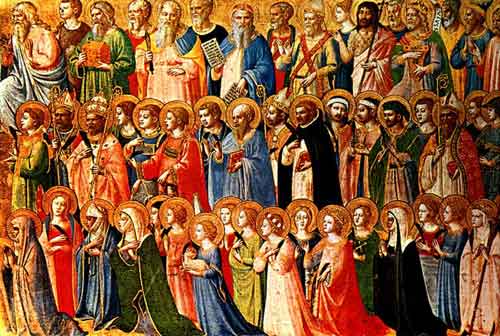 OOOOOOOh Yea ….!!!
OOOOOOOh Yea ….!!!
Tags: saints
This entry was posted on Thursday, November 1st, 2012 at 12:09 am
You can follow any responses to this entry through the RSS 2.0 feed.
On October 7, at the beginning of the Synod on the New Evangelization, 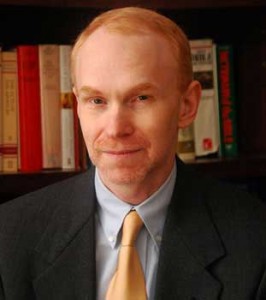 Pope Benedict XVI will declare St. Hildegard von Bingen and St. John of Avila  Doctors of the Church.  On this special edition of Inside the Pages I talk with Dr. Matthew Bunson about the significance of this declaration.  We talk about the lives and work of both saints and how their teachings can touch our lives today.
Pope Benedict XVI will declare St. Hildegard von Bingen and St. John of Avila  Doctors of the Church.  On this special edition of Inside the Pages I talk with Dr. Matthew Bunson about the significance of this declaration.  We talk about the lives and work of both saints and how their teachings can touch our lives today.
[powerpress]
Tags: catholic, catholic podcast, catholic prayer, cathollc spirituality, Church, matthew bunson, saints, work
This entry was posted on Sunday, October 14th, 2012 at 12:06 am
You can follow any responses to this entry through the RSS 2.0 feed.
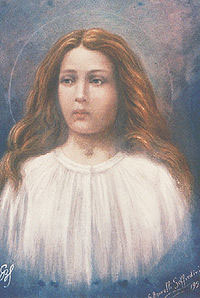
 MESSAGE OF JOHN PAUL II TO THE BISHOP OF ALBANO FOR THE CENTENARY OF THE DEATH OF ST. MARIA GORETTI from Vatican.va
MESSAGE OF JOHN PAUL II TO THE BISHOP OF ALBANO FOR THE CENTENARY OF THE DEATH OF ST. MARIA GORETTI from Vatican.va
To my Venerable Brother Bishop Agostino Vallini of Albano
1. A hundred years ago, on 6 July 1902, Maria Goretti died in the hospital at Nettuno, brutally stabbed the day before in the little village of Le Ferriere, in the Pontine Marshes. Her spiritual life, the strength of her faith, her ability to forgive her murderer have placed her among the best-loved saints of the 20th century. Appropriately, therefore, the Congregation of the Passion (C.P.), entrusted with the care of the shrine where the saint’s remains repose, wanted to celebrate the anniversary with special solemnity.
St Maria Goretti was a girl whom God’s Spirit endowed with the courage to stay faithful to her Christian vocation even to the point of making the supreme sacrifice of her life. Her tender age, her lack of education and the poverty of the environment in which she lived did not prevent grace from working its miracles in her. Indeed, it was precisely in these conditions that God’s special love for the lowly appeared. We are reminded of the words with which Jesus blesses the heavenly Father for revealing himself to children and the simple, rather than to the wise and learned of the world (cf. Mt 11,25).
It was rightly observed that St Maria Goretti’s martyrdom heralded what was to be known as the century of martyrs. It was in this perspective that at the end of the Great Jubilee of the Year 2000, I stressed that “this lively sense of repentance … has not prevented us from giving glory to the Lord for what he has done in every century, and in particular during the century which we have just left behind, by granting his Church a great host of saints and martyrs” (Novo Millennio ineunte, n. 7).
2. Maria Goretti, born in Corinaldo in The Marches on 16 October 1890, was soon obliged to emigrate with her family, and after sometime they arrived at Le Ferriere di Conca in the Pontine Marshes. Despite the hardships of poverty which even prevented her from going to school, little Maria lived in a serene and united family atmosphere, enlivened by Christian faith, in which the children felt welcomed as a gift and were taught by their parents self-respect and respect for others, as well as a sense of duty based on love of God. This enabled the little girl to grow up peacefully, nourishing her simple but deep faith. The Church has always recognized the role of the family as the first and fundamental place for the sanctification of its members, starting with the children.
In this family environment Maria assimilated steadfast trust in God’s provident love, which she showed in particular at the death of her father, who died of malaria. “Mother, be brave, God will help us”, the little girl was in the habit of saying in those difficult times, bravely reacting to her deep feeling of loss at her father’s death.
3. In the homily for her canonization, Pope Pius XII of venerable memory pointed to Maria Goretti as “the sweet little martyr of purity” (cf. Discorsi e Radiomessaggi, XII [1950-1951], 121), because she did not break God’s commandment in spite of being threatened by death.
What a shining example for young people! The non-commital mindset of much of our society and culture today sometimes has a struggle to understand the beauty and value of chastity. A high and noble perception of dignity, her own and that of others emerges from the behaviour of this young saint, was mirrored in her daily choices, giving them the fullness of human meaning. Is not there a very timely lesson in this? In a culture that idolizes the physical aspect of the relations between a man and a woman, the Church continues to defend and to champion the value of sexuality as a factor that involves every aspect of the person and must therefore be lived with an interior attitude of freedom and reciprocal respect, in the light of God’s original plan. With this outlook, a person discovers he or she is being given a gift and is called, in turn, to be a gift to the other. (more…)
Tags: catholic, catholic podcast, catholic prayer, cathollc spirituality, Church, forgiveness, Le Ferriere, Maria Goretti, pope john paul ii, saints, st. maria goretti
This entry was posted on Friday, July 6th, 2012 at 12:07 am
You can follow any responses to this entry through the RSS 2.0 feed.
We love to hear the stories of the lives of the saints, especially those we are not familiar with! Â So we owe a big thank you to
Brian O’Neel for shining the light on 39 holy unknowns in “Saint Who?”. Â Â Men and women, clerics, religious, and laity, married and single, there’s story from all walks of life. Â The book contains a short biography of each saint, a section on why that saint merits our attention and devotion today, and a short prayer. Â He also discusses with us what makes a blessed, what makes them a saint. Â A wonderful read.
[powerpress]
You can find the book here
Thousands of saints are formally recognized by the Catholic Church. While some are household names, have you heard of:
- St. Bathilde, the slave queen?
- St. Pietro Parenzo, the heavenly politician?
- Bl. Sebastian de Aparicio, the first cowboy?
- St. Mary Helen MacKillop, the excommunicated saint?
From these now-obscure saints or blesseds come amazing stories of virtue, vice, and the triumph of grace. Brian O’Neel tells these tales, often colorful and always compelling, with humor tempered by an obvious love for his subjects, explaining why they deserve our attention and devotion.
Tags: catholic, catholic podcast, catholic prayer, cathollc spirituality, saints
This entry was posted on Saturday, June 23rd, 2012 at 6:23 am
You can follow any responses to this entry through the RSS 2.0 feed.
Trial and execution
Committed to the Tower of London, he was questioned in the presence of Queen Elizabeth, who asked him if he acknowledged her to be the true Queen of England. He replied she was, and she offered him wealth and dignities, but on condition of rejecting his Catholic faith, which he refused to accept. He was kept a long time in prison and reputedly racked twice. Despite the effect of a false rumour of retraction and a forged confession, his adversaries summoned him to four public conferences (September 1, 18, 23 and 27, 1581). Although still suffering from his ill treatment, and allowed neither time nor books for preparation, he reportedly conducted himself so easily and readily that he won the admiration of most of the audience. Tortured again on October 31, he was indicted at Westminster on a charge of having conspired, along with others, in Rome and Reims to raise a sedition in the realm and dethrone the Queen.
Edmund Campion, in a 1631 print.Campion was sentenced to death as a traitor. He answered: “In condemning us, you condemn all your own ancestors, all our ancient bishops and kings, all that was once the glory of England — the island of saints, and the most devoted child of the See of Peter.” He received the death sentence with the Te Deum laudamus. After spending his last days in prayer he was led with two companions, Ralph Sherwin and Alexander Briant, to Tyburn where the three sainted martyrs were hanged, drawn and quartered on December 1, 1581. He was 41 years of age.
Veneration and Feast Day
Edmund Campion was beatified by Pope Leo XIII on December 9, 1886. Blessed Edmund Campion was canonized nearly eighty-four years later in 1970 by Pope Paul VI as one of the Forty Martyrs of England and Wales with a common feast day of May 4. His feast day is celebrated on December 1, the day of his martyrdom.
The actual ropes used in his execution are now kept in glass display tubes at Stonyhurst College in Lancashire; each year they are placed on the altar of St Peter’s Church for Mass to celebrate Campion’s feast day—which is always a holiday for the school. – wiki
A Daily Prayer of St. Edmund
“I have made a free oblation of myself
to your Divine Majesty,
both of life and of death,
and I hope that
you will give me
grace and force to perform.
This is all I desire. Amen.”
-St. Edmund Campion
Tags: Blessed Edmund Campion, catholic, catholic podcast, catholic prayer, cathollc spirituality, death, edmund campion, england, feast day, Feast Day Edmund Campion, martyr, martyrdom, martyrs of england, queen elizabeth, Queen of England, saints
This entry was posted on Thursday, December 1st, 2011 at 12:02 am
You can follow any responses to this entry through the RSS 2.0 feed.
I LOVE talking with Fr. James Martin, especially about the saints!  “Between Heaven and Mirth: Why Joy,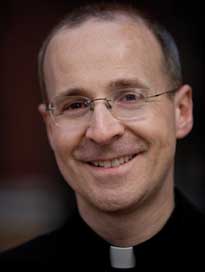 Humor, and Laughter Are at the Heart of the Spiritual Life” is fantastic! I don’t think there’s another book like it out there. Fr. Martin takes Scripture, history, the Saints, and the basics of our faith and the spiritual life, and wraps them  all together to bring us a unique and wonderful study of joy and happiness. To say it was uplifting to read would be an understatement.  Others have tried to write humorous books about the Christian faith, but often times their attempts come  off little crass and a tad tasteless….but not Fr. Jim Martin, that’s because it about joy, happiness and grace…and he leads to the well where we can find it.  [powerpress]
Humor, and Laughter Are at the Heart of the Spiritual Life” is fantastic! I don’t think there’s another book like it out there. Fr. Martin takes Scripture, history, the Saints, and the basics of our faith and the spiritual life, and wraps them  all together to bring us a unique and wonderful study of joy and happiness. To say it was uplifting to read would be an understatement.  Others have tried to write humorous books about the Christian faith, but often times their attempts come  off little crass and a tad tasteless….but not Fr. Jim Martin, that’s because it about joy, happiness and grace…and he leads to the well where we can find it.  [powerpress]
You can find the book here
Tags: catholic, catholic podcast, catholic prayer, cathollc spirituality, fr. james martin, humor, James Martin, Jim Martin, Mirth, saints
This entry was posted on Wednesday, October 5th, 2011 at 10:19 am
You can follow any responses to this entry through the RSS 2.0 feed.

